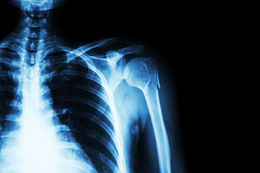
Orthopedics is a continually evolving field with what seems like constant changes taking place. The doctors in our region are keeping up with these changes and even making some of the latest advances. This has equated to an overall better experience for the patient with improved outcomes.
It’s no surprise that one of the biggest areas of advancement in the field of orthopedics has been in joint replacement surgery. Improvements in joint replacement materials, surgical techniques and pain management and rehab options have improved the experience for patients.
Advances have even taken place on the imaging side. In terms of joint replacement, Dr. Dennis C. Lin, of South Jersey Radiology Associates, says they’ve been seeing an increasing use of patient specific instrumentation.
“Basically, the patient gets a preoperative MRI or CT scan which is then sent to the joint replacement manufacturer,” Lin explains. “The manufacturer can then determine the appropriate size implant for that patient and create custom jigs for the orthopedic surgeon to use to make the appropriate cuts in the bone when placing the prosthesis. The promise of this is reduction in error when positioning implants and, as a result, it reduces the likelihood of implant failure down the line.”
Lin adds that improvements in imaging, in general, are also helping orthopedic doctors and surgeons to get better pictures and therefore make more accurate evaluations on necessary steps. “Orthopedic imaging has improved significantly over the last decade,” he says. “With higher strength MRIs we are now able to obtain higher resolution images, thus being able to see finer anatomic detail— particularly helpful in the hands, wrists, elbows, ankles and feet.”
Evaluating patients after surgery has also improved thanks to advancements in metal suppression techniques that reduce metal artifact from orthopedic hardware. Previously that complication made MRIs unreadable.
Surgical advances
With surgery in general, the trend has been toward more minimally invasive procedures and it’s been no different with joint replacement surgery. Improved techniques are allowing surgeons to complete procedures in a shorter amount of time with less trauma damage to surrounding tissue, says Dr. Sean McMillan, chief of orthopedics and director of orthopedic sports medicine at Lourdes Medical Center of Burlington County. With regard to joint replacement procedures, that has meant that surgeries which may have taken hours in the past are sometimes able to be performed in under an hour. This equates to less time under anesthesia and a quicker recovery for the patient.
McMillan says that the field has also come incredibly far in their understanding and use of medication. Surgeons are always looking for the best ways to manage their patients’ pain and McMillan makes a point to keep up with the latest research in the field. One thing that he does differently is try to wean patients from painkiller use prior to their joint replacement surgery.
“If you can get off narcotics before your surgery, your pain threshold is going to be so much better after,” McMillan explains. “We may delay the surgery in order to wean those narcotics— which is admittedly hard—but we really want you to have the best outcome afterwards. We work closely with patients to minimize their pain with anti-inflammatories. To me, nothing is worse than operating on a patient and then finding that their pain is off the charts after surgery. We are making multiple efforts to keep pain to a minimum and really help them through that recovery period.”
The recovery period
McMillan says that another huge change in the field is the amount of time patients can anticipate spending in the hospital. In the past, a joint replacement procedure could mean a stay of a week or more. Today, he’s doing a lot of same-day replacements. Studies have shown that patients actually recover quicker—and better— outside of the hospital in most cases. While some patients may still be transferred to a rehabilitation facility, some are going home and receiving in-home therapy for their recovery.
Dr. Kenneth Wu, medical director at Kessler Institute for Rehabilitation-Marlton, has seen patients make it into the rehab phase and recover quicker and with a lot less pain. He surmises it is the better technology and advanced procedures that surgeons are using contributing to an improved recovery period for the patient.
“We’re seeing patients have a lot more functionality right away,” Wu says. “It’s gotten to the point where a lot of joint replacement procedures are same-day procedures and then they may be transferred here. We get the therapy going right away and keep the patient moving.”
Wu says we are in a day-and-age where “quality of care” is a main goal of any surgical procedure. As improvements are continually made, the patient’s wellbeing is always at the forefront of healthcare professionals’ minds.
“Everything in health care is being driven by quality of care,” Wu adds. “We’re seeing better pain management and more focus on what the patient needs. We’re also getting patients home a lot quicker which means less infection and better quality of life. All around, it’s safe to say the field has come a long way.”
A strong back
Elsewhere, exciting advances in the field of chiropractic care are not only benefiting patients, in some cases it is helping them avoid surgery completely. However, experts say it’s always prudent to take the most conservative approach, first.
Dr. Michael J. O’Keefe, of O’Keefe Chiropractic Center, has been utilizing a cutting-edge technology called spinal decompression therapy to help treat his patients. This non-surgical, computer- modulated traction device is programmed to deliver gentle stretching at the patient’s lower back or around their hips. The negative pressure allows a disc to be pulled back into its proper position with no pain whatsoever. That’s important as many of the patients who come to see O’Keefe are already in tremendous pain and scared to be touched as a result.
“What makes spinal decompression therapy unique is that it is truly painless,” O’ Keefe says. “I know some patients may be frightened as they are in so much pain. They want a solution but they’re also scared to try something new. Patients find this relaxing and relieving. The worstcase scenario is that it doesn’t work but it will not make the patient worse so it’s absolutely worth trying.”
Published (and copyrighted) in South Jersey Magazine, Volume 14, Issue 3 (June, 2017).
For more info on South Jersey Magazine, click here.
To subscribe to South Jersey Magazine, click here.
To advertise in South Jersey Magazine, click here.











